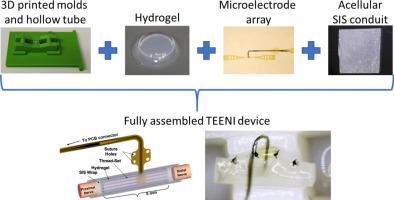当前位置:
X-MOL 学术
›
J. Neurosci. Methods
›
论文详情
Our official English website, www.x-mol.net, welcomes your
feedback! (Note: you will need to create a separate account there.)
Integration of flexible polyimide arrays into soft extracellular matrix-based hydrogel materials for a tissue-engineered electronic nerve interface (TEENI).
Journal of Neuroscience Methods ( IF 2.7 ) Pub Date : 2020-05-13 , DOI: 10.1016/j.jneumeth.2020.108762 Benjamin S Spearman 1 , Cary A Kuliasha 2 , Jack W Judy 2 , Christine E Schmidt 1
Journal of Neuroscience Methods ( IF 2.7 ) Pub Date : 2020-05-13 , DOI: 10.1016/j.jneumeth.2020.108762 Benjamin S Spearman 1 , Cary A Kuliasha 2 , Jack W Judy 2 , Christine E Schmidt 1
Affiliation

|
BACKGROUND
Biomimetic hydrogels used in tissue engineering can improve tissue regeneration and enable targeted cellular behavior; there is growing interest in combining hydrogels with microelectronics to create new neural interface platforms to help patient populations. However, effective processes must be developed to integrate flexible but relatively stiff (e.g., 1-10 GPa) microelectronic arrays within soft (e.g., 1-10 kPa) hydrogels.
NEW METHOD
Here, a novel method for integrating polyimide microelectrode arrays within a biomimetic hydrogel scaffold is demonstrated for use as a tissue-engineered electronic nerve interface (TEENI). Tygon tubing and a series of 3D printed molds were used to facilitate hydrogel fabrication and device assembly.
COMPARISON WITH EXISTING METHODS
Other comparable regenerative peripheral nerve interface technologies do not utilize the flexible microelectrode array design nor the hydrogel scaffold described here. These methods typically use stiff electrode arrays that are affixed to a similarly stiff implantable tube serving as the nerve guidance conduit.
RESULTS
Our results indicate that there is a substantial mechanical mismatch between the flexible microelectronic arrays and the soft hydrogel. However, using the methods described here, there is consistent fabrication of these regenerative peripheral nerve interfaces suitable for implantation.
CONCLUSIONS
The assembly process that was developed resulted in repeatable and consistent integration of microelectode arrays within a soft tissue-engineered hydrogel. As reported elsewhere, these devices have been successfully implanted in a rat sciatic nerve model and yielded neural recordings. This process can be adapted for other applications and hydrogels in which flexible electronic materials are combined with soft regenerative scaffolds.
中文翻译:

将柔性聚酰亚胺阵列集成到基于软细胞外基质的水凝胶材料中,用于组织工程电子神经接口(TEENI)。
背景技术用于组织工程的仿生水凝胶可以改善组织再生并实现靶向细胞行为;人们越来越有兴趣将水凝胶与微电子技术相结合,创建新的神经接口平台来帮助患者群体。然而,必须开发有效的工艺来将柔性但相对刚性(例如,1-10 GPa)的微电子阵列集成到软(例如,1-10 kPa)水凝胶中。新方法在这里,一种将聚酰亚胺微电极阵列集成到仿生水凝胶支架中的新方法被证明可用作组织工程电子神经接口(TEENI)。使用 Tygon 管和一系列 3D 打印模具来促进水凝胶制造和设备组装。与现有方法的比较其他可比较的再生周围神经接口技术不利用此处描述的柔性微电极阵列设计或水凝胶支架。这些方法通常使用坚硬的电极阵列,这些电极阵列固定在用作神经引导导管的类似坚硬的可植入管上。结果我们的结果表明柔性微电子阵列和软水凝胶之间存在显着的机械不匹配。然而,使用此处描述的方法,可以一致地制造这些适合植入的再生周围神经接口。结论所开发的组装工艺导致微电极阵列在软组织工程水凝胶中可重复且一致地集成。正如其他地方报道的那样,这些设备已成功植入大鼠坐骨神经模型并产生神经记录。 该过程可适用于其他应用和水凝胶,其中柔性电子材料与软再生支架相结合。
更新日期:2020-05-13
中文翻译:

将柔性聚酰亚胺阵列集成到基于软细胞外基质的水凝胶材料中,用于组织工程电子神经接口(TEENI)。
背景技术用于组织工程的仿生水凝胶可以改善组织再生并实现靶向细胞行为;人们越来越有兴趣将水凝胶与微电子技术相结合,创建新的神经接口平台来帮助患者群体。然而,必须开发有效的工艺来将柔性但相对刚性(例如,1-10 GPa)的微电子阵列集成到软(例如,1-10 kPa)水凝胶中。新方法在这里,一种将聚酰亚胺微电极阵列集成到仿生水凝胶支架中的新方法被证明可用作组织工程电子神经接口(TEENI)。使用 Tygon 管和一系列 3D 打印模具来促进水凝胶制造和设备组装。与现有方法的比较其他可比较的再生周围神经接口技术不利用此处描述的柔性微电极阵列设计或水凝胶支架。这些方法通常使用坚硬的电极阵列,这些电极阵列固定在用作神经引导导管的类似坚硬的可植入管上。结果我们的结果表明柔性微电子阵列和软水凝胶之间存在显着的机械不匹配。然而,使用此处描述的方法,可以一致地制造这些适合植入的再生周围神经接口。结论所开发的组装工艺导致微电极阵列在软组织工程水凝胶中可重复且一致地集成。正如其他地方报道的那样,这些设备已成功植入大鼠坐骨神经模型并产生神经记录。 该过程可适用于其他应用和水凝胶,其中柔性电子材料与软再生支架相结合。











































 京公网安备 11010802027423号
京公网安备 11010802027423号